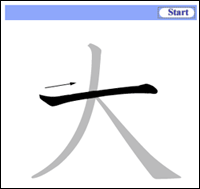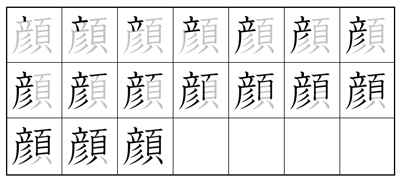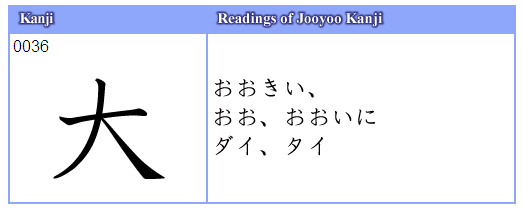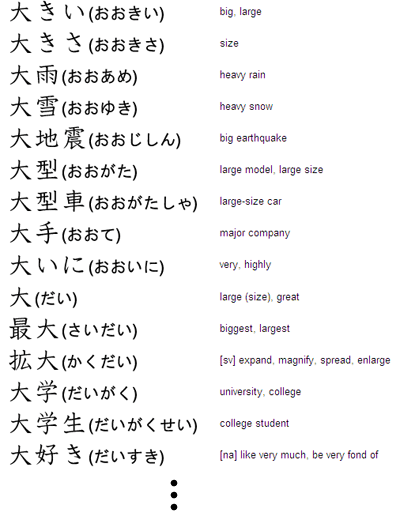Effective Kanji Learning
There are different ways to learn Kanji. You may start with simple characters then move on to complicated characters, group similar Kanji, or group them by meanings of Kanji.
However there are so many Kanji and they are complicated. About 2,000 characters based on Joyo Kanji are used in general Japanese documents, but most Kanji represent 2 or more readings, along with some Kanji representing 4 or more readings.
This is what makes Kanji learning hard. Memorizing 2,000 characters and all the readings represented by each of the characters will require tremendous amount of time and effort. Realistically it is extremely hard for most learners.
Luckily however, not all of the multiple readings are important. Some are frequently used and some are rarely used. It is necessary to separate important Kanji from less important Kanji, important readings from less important readings and focus on the vital things in order to learn Kanji efficiently.
1,110 characters cover 90%
General Japanese documents consist of about 2,000 characters based on Joyo Kanji, of which 1,000 characters are frequently used.
CosCom carefully selected 2,301 characters including 2,136 Joyo Kanjis and 164 Non-Joyo Kanjis, and 1 symbol. We categorized those 2,301 characters into 4 levels based on how often they are used.
| Level 1 | 555 characters | Very frequently used |
| Level 2 | 555 characters (1110 in total) | Frequently used |
| Level 3 | 891 characters (2001 in total) | Less frequently used compared to the above 2 levels. |
| Level 4 | 300 characters (2301 in total) | Joyo Kanjis used in names, or hardly used Non-Joyo Kanjis which are commonly used |
According to our research 60% - 70% of Kanji that appear in newspaper and magazine articles or general business documents are covered by Level 1 Kanji. With 555 characters of Level 2 added, they cover over 90% of Kanji that appear in general documents overall.
Learning those 1,110 characters with priority is the most efficient way of Kanji learning.
Unique, Effective Kanji Material - 2001.Kanji.Odyssey
Based on our research CosCom developed unique Kanji learning material, the audio e-book 2001.Kanji.Odyssey.
The first edition was published in 2003 that contained 2,001 characters.
In 2010, CosCom added 300 Kanji characters including 196 new Joyo Kanjis.
The latest 2001.Kanji.Odyssey consists of 2,301 characters.
Focus on important readings
Main Section & Reference Section
There may be more than one reading for single Kanji, but not all readings are frequently used.
With most Kanji, only one or two readings per Kanji are frequently used. So we separated readings of each Kanji into important and unimportant ones.
In Audio e-Book 2001.Kanji.Odyssey, there are both Main Section and Reference Section for every Kanji in Level 1 and Level 2.
In Main Section important readings of each Kanji and related important Jukugo (Kanji compound) are presented, along with audio for all important Jukugo. Also prepared are over 3,000 example sentences using above referenced Jukugo. Kanji stroke orders included.
Nearly all Joyo Kanji readings of each Kanji and a list of Jukugo are included in Reference Section.
Students can focus on important readings and important Jukugo in Main Section, while using Reference Section as dictionary.
Audio e-Book 2001.Kanji.Odyssey contains;
| Main Section | Reference Section | |
|---|---|---|
| Level 1 |
Important readings Important vocabulary with Audio Example sentences with Audio & English translation Stroke order |
Almost all Joyo Kanji readings and many Kanji vocabularies |
| Level 2 | ||
| Level 3 |
Important readings Important vocabulary with Audio Example sentences with vocabulary list |
Almost all Joyo Kanji readings and many Kanji vocabularies |
| Level 4 |
Important readings Important vocabulary with Audio |
Almost all Joyo Kanji readings and many Kanji vocabularies |
Main Section (Level 1, Level 2)
Important readings & vocabulary with audio

Stroke order - Level 1

Stroke order - Level 2

Reference Section
Reference Section contains nearly all Joyo Kanji readings of each Kanji and a list of Jukugo.


See Repetitively
Over 3,000 Example sentences with link to each Kanji
All examples are voice-recorded
Kanji is complicated and many Kanji look similar. So it is likely for students to mix up a Kanji with others or quickly forget after learning just once.
You must repeatedly see them in order to not forget Kanji you once learned.
For this purpose we prepared over 3,000 example sentences in this material.
All sentences are written using Level 1 and Level 2 Kanji only, and they are specifically written to show ready-learned Kanji repeatedly.
There are 2 types of Ruby for each sentence. Type 1 includes Ruby for all Kanji.
Type 2 includes Ruby for new Kanji only and there is no Ruby for ready-learned Kanji.
(Essential Japanese Kanji 1110 includes Type 1)
All Kanji from example sentences are listed at the bottom with Kanji Numbers.
When using Audio e-Book you can click Kanji to display its Reference Section.
If you have forgotten Kanji in the sentence, you can quickly check it with this function.
Ruby
Hiragana written above Kanji to represent the reading is called Ruby or Furigana.
Effective Grouping
Grouping is a main feature in 2001.Kanji.Odyssey.
Level 1 and Level 2 Kanji are grouped by 5 characters. Each group is sorted by using effective method, into Kanji of similar shapes, related meanings or Kanji to combine and form Jukugo (compound).
Group 8
 |
 |
 |
 |
 |
| big, large | inside, medium |
small | few | many |
Group 24
 |
 |
 |
 |
 |
| eat | drink | meal | buy | watch |
Group 25
 |
 |
 |
 |
 |
| say, tell | talk, speak | read | language | English |
As above examples show, each group consists of Kanji which are related in meanings and shapes.
Leaning by such group units is extremely effective as you can memorize and relate each character to another.









